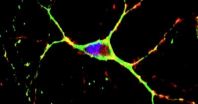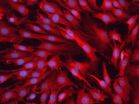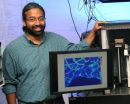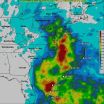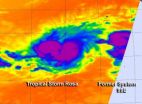(Press-News.org) There's new hope in the fight against Huntington's disease. A group of researchers that includes scientists from the U.S. Department of Energy's Lawrence Berkeley National Laboratory (Berkeley Lab) have designed a compound that suppresses symptoms of the devastating disease in mice.
The compound is a synthetic antioxidant that targets mitochondria, an organelle within cells that serves as a cell's power plant. Oxidative damage to mitochondria is implicated in many neurodegenerative diseases including Alzheimer's, Parkinson's, and Huntington's.
The scientists administered the synthetic antioxidant, called XJB-5-131, to mice that have a genetic mutation that triggers Huntington's disease. The compound improved mitochondrial function and enhanced the survival of neurons. It also inhibited weight loss and stopped the decline of motor skills, among other benefits. In short, the Huntington's mice looked and behaved like normal mice.
Based on their findings, the scientists believe that XJB-5-131 is a promising therapeutic compound that deserves further investigation as a way to fight neurodegenerative diseases.
They report their research in a paper that appears online Nov. 1 in the journal Cell Reports.
"The compound was very successful. More research is needed, but it has the real potential to make an impact in treating neurodegenerative disorders," says Cynthia McMurray of Berkeley Lab's Life Sciences Division. She conducted the research with other Berkeley Lab researchers, including Zhiyin Xun, and scientists from the University of Pittsburgh.
Huntington's disease is a genetic disorder in which neurons in certain parts of the brain waste away. Symptoms of the disease typically appear in mid-life. These include loss of muscle coordination and cognitive decline. There is no cure. Currently, patients are prescribed antidepressants or compounds that reduce the loss of motor coordination, neither of which delays the disease's progression.
Another intriguing line of defense could be in the form of therapies that protect mitochondria from chemically reactive molecules that contain oxygen. These molecules, called reactive oxygen species, inflict oxidative damage on mitochondria that disrupts their function and leads to cell death.
But defending mitochondria from reactive oxygen species is a tall order. That's because mitochondria are both the main target of these molecules, and a cell's primary source of them. In other words, mitochondria produce the very thing that damages them.
Researchers have studied whether dietary supplements of natural antioxidants such as vitamin E and coenzyme Q can mitigate the harmful effects of reactive oxygen species on mitochondria. Natural antioxidants don't target specific tissue within the body, however. And they've been shown to yield only marginal benefits in human clinical trials.
These lackluster results have driven scientists to develop synthetic antioxidants that specifically target mitochondria. A few years ago, University of Pittsburgh chemist Peter Wipf synthesized an antioxidant called XJB-5-131 that zeroes in on bacterial membranes, which are very similar to mitochondrial membranes. He also found that this compound dramatically improves cellular survival. But its effectiveness against neurodegenerative diseases was unknown.
That's where Cynthia McMurray's lab comes in. Several years ago, her team began exploring ways to study a genetic mutation that causes Huntington's disease. They've since developed a mouse model with this mutation that enables the scientists to evaluate how the disease affects mice, which is a fairly good proxy for humans. In addition, Zhiyin Xun learned how to isolate nerve terminals and mitochondria from a mouse's brain, enabling the scientists to study the organelle's role in the disease.
The scientists first injected Huntington's mice with XJB-5-131 and tested the mice's motor skills. In one test, the mice were placed on a spinning rotarod, which forces them to balance like a lumberjack at a log rolling competition. The non-treated Huntington's mice performed progressively worse as they aged. The XJB-treated Huntingon's mice performed as well as normal mice over the same period.
In another test, grip strength was measured by prompting the mice to hang on a bar for 30 seconds. Almost all of the non-treated Huntington's mice failed the test, while 85 percent of the XJB-treated Huntington's mice passed the test. The treatment also stopped weight loss in Huntington's mice, which is another hallmark of the disease.
"We saw improvements across the board. The difference was amazing. XJB prevented the onset of weight loss and the decline in motor skills," says McMurray.
Next, the researchers removed neurons from the Huntington's mice and cultured the cells in the presence of XJB-5-131. They found that XJB-5-131 significantly improved the survival of neuronal cultures compared to untreated neuronal cultures.
Xun and colleagues also studied the impacts of the compound on the mice's mitochondrial DNA. They discovered that XJB-5-131 dramatically lowered the number of lesions on the DNA, which is a sign of oxidative damage. They also tallied the number of mitochondrial DNA copies, which plummets in diseased mice. This number was restored back to normal in XJB-treated mice.
In addition, Xun isolated nerve terminals from the Huntington mice's striatum and cerebral cortex, two parts of the brain that are affected by Huntington's disease. She found that XJB-5-131 significantly improved the ability of the mitochondria within these nerve terminals to respond to stress.
She also exposed mitochondria to a chemical that induces the formation of reactive oxygen species. As expected, this impaired mitochondrial function. But when the chemical was used along with XJB-5-131, mitochondrial function recovered.
Xun is now working to determine how exactly the compound rescues mitochondria from oxidative damage. The scientists also want to test the effectiveness of several promising derivatives. And they believe that clinical trials may not be far off given their initial success and the dire nature of the disease.
"Huntington's is a desperate disorder, so we are very eager to help find therapies that can stop its progression," says McMurray.
INFORMATION:
This research was supported by the National Institutes of Health.
Lawrence Berkeley National Laboratory addresses the world's most urgent scientific challenges by advancing sustainable energy, protecting human health, creating new materials, and revealing the origin and fate of the universe. Founded in 1931, Berkeley Lab's scientific expertise has been recognized with 13 Nobel prizes. The University of California manages Berkeley Lab for the U.S. Department of Energy's Office of Science. For more, visit www.lbl.gov.
Berkeley Lab scientists help develop promising therapy for Huntington's disease
Initial results in mice could lead to new way to fight neurodegenerative diseases
2012-11-02
ELSE PRESS RELEASES FROM THIS DATE:
The ins and outs of in-groups and out-groups
2012-11-02
We humans organize ourselves in myriad kinds of social groups, from scout troops and sports teams to networks of friends, colleagues, or classmates. But how do these social groups work? How do we decide whom to trust and whom to follow? And how do we deal with people that don't seem to fit the norms of our social groups?
New research published in Psychological Science, a journal of the Association for Psychological Science, explores these issues by examining various facets of social perception and behavior.
The Herding Hormone: Oxytocin Stimulates In-Group Conformity
Mirre ...
Bigger human genome pool uncovers rarer variants
2012-11-02
Contact:
Iman Hajirasouliha, 778.782.7040, 604.418.4834 (cell), imanh@sfu.ca
Carol Thorbes, PAMR, 778.782.3035, cthorbes@sfu.ca
Flickr: http://at.sfu.ca/skirFz END ...
UC Davis scientists identify new target for lung cancer treatment
2012-11-02
(SACRAMENTO, Calif.) — A team of UC Davis investigators has discovered a protein on the surface of lung cancer cells that could prove to be an important new target for anti-cancer therapy. A series of experiments in mice with lung cancer showed that specific targeting of the protein with monoclonal antibodies reduced the size of tumors, lowered the occurrence of metastases and substantially lengthened survival time. The findings will be published in the November issue of Cancer Research.
"Lung cancer continues to be one of the biggest killers in the United States, and ...
How the negative trumps the positive in politics
2012-11-02
Negatively framed political attitudes ("I don't like Obama") are stronger than positively framed attitudes ("I like Romney"), and this effect is strengthened when people think more deeply about the issues involved.
That is the finding of a paper published in the latest issue of the British Journal of Social Psychology by George Bizer, a psychology professor at Union College in Schenectady, N.Y.
Bizer and his co-authors Iris Žeželj (University of Belgrade) and Jamie Luguri (Yale University) presented participants with information about two fictional (though ostensibly ...
New light on the genetic basis of inflammatory diseases
2012-11-02
In one of the largest studies of its kind ever conducted, an international team of scientists has thrown new light on the genetic basis of the inflammatory bowel diseases (IBD). Crohn's disease and ulcerative colitis, the two most common forms of IBD, are chronic inflammatory digestive disorders affecting 230,000 Canadians. Dr. John Rioux, researcher at the Montreal Heart Institute and Associate Professor of Medicine at the Université de Montréal, is one of the researchers who have identified 71 genetic regions newly associated with inflammatory bowel disease (IBD), increasing ...
Combination treatment may improve survival of breast cancer patients with brain metastases
2012-11-02
Adding an angiogenesis inhibitor to treatment with a HER2-inhibiting drug could improve outcomes for patients with HER2-positive breast cancer who develop brain metastases. In their report published online in PNAS Plus, Massachusetts General Hospital (MGH) investigators report the first preclinical study combining antiangiogenic and anti-HER2 drugs in an animal model of brain metastatic breast cancer.
"We have shown dramatic improvement in survival by slowing the growth of brain metastatic, HER2-amplified breast cancer," says Rakesh Jain, PhD, director of the Steele ...
Softening arteries, protecting the heart
2012-11-02
PHILADELPHIA - Arterial stiffening has long been considered a major risk factor for cardiovascular disease. Keeping arteries soft and supple might reduce disease risk, but the mechanisms of how arteries stave off hardening has remained elusive.
Researchers from the Perelman School of Medicine, University of Pennsylvania, Wistar Institute, and The Children's Hospital of Philadelphia have discovered that the protein apolipoprotein E (apoE) plays a major role in maintaining arterial softness by suppressing production of the extracellular matrix, a network of connective ...
Iowa State, Ames Lab researchers find 3 unique cell-to-cell bonds
2012-11-02
AMES, Iowa – The human body has more than a trillion cells, most of them connected, cell to neighboring cells.
How, exactly, do those bonds work? What happens when a pulling force is applied to those bonds? How long before they break? Does a better understanding of all those bonds and their responses to force have implications for fighting disease?
Sanjeevi Sivasankar, an Iowa State assistant professor of physics and astronomy and an associate of the U.S. Department of Energy's Ames Laboratory, is leading a research team that's answering those questions as it studies ...
NASA adds up Hurricane Sandy's rainfall from space
2012-11-02
NASA's Tropical Rainfall Measuring Mission, or TRMM, satellite acts as a rain gauge in space as it orbits the Earth's tropics. As TRMM flew over Hurricane Sandy since its birth on Oct. 21 it was gathering data that has now been mapped to show how much rain the storm dropped along the U.S. eastern seaboard.
Much of the recent deadly flooding along the northeastern United States coastlines was caused by super storm Sandy's storm swell. Strong winds from Sandy persistently pushed Atlantic Ocean waters toward the coast. High tides that occurred at the same time also magnified ...
NASA sees Tropical Storm Rosa's rains southeast of center
2012-11-02
Wind shear is pushing the bulk of Tropical Storm Rosa southeast of the storm's center, and that's evident on infrared imagery from NASA's Aqua satellite. Meanwhile System 99E, that was trailing behind Rosa on Oct. 31, has now "given up the ghost" as a result of that same wind shear.
When NASA's Aqua satellite flew over Tropical Storm Rosa at 5:41 a.m. EDT (0951 UTC) on Nov. 1, 2012 the Atmospheric Infrared Sounder (AIRS) instrument took an infrared picture of Tropical Storm Rosa and remnants of System 99E. The AIRS data showed the strongest convection (rising air that ...
LAST 30 PRESS RELEASES:
Chronic breathlessness emerging as a hidden strain on hospitals
Paleontologists find first fossil bee nests made inside fossil bones
These fossils were the perfect home for ancient baby bees
Not everyone reads the room the same. A new study examines why.
New research identifies linked energy, immune and vascular changes in ME/CFS
Concurrent frailty + depression likely boost dementia risk in older people
Living in substandard housing linked to kids’ missed schooling and poor grades
Little awareness of medical + psychological complexities of steroid cream withdrawal
Eight in 10 trusts caring for emergency department patients in corridors, finds BMJ investigation
NASA’s Webb telescope finds bizarre atmosphere on a lemon-shaped exoplanet
The gut bacteria that put the brakes on weight gain in mice
Exploring how patients feel about AI transcription
Category ‘6’ tropical cyclone hot spots are growing
Video: Drivers struggle to multitask when using dashboard touch screens, study finds
SLU research shows surge in alcohol-related liver disease driving ‘deaths of despair’
Rising heat reshapes how microbes break down microplastics, new review finds
Roots reveal a hidden carbon pathway in maize plants
Membrane magic: FAMU-FSU researchers repurpose fuel cells membranes for new applications
UN Member States pledge to increase access to diagnosis and inhaled medicines for the 480 million people living with COPD
Combination therapy shows potential to treat pediatric brain cancer ATRT
Study links seabird nesting to shark turf wars in Hawai‘i
Legal sports betting linked to sharp increases in violent crime, study finds
Breakthrough AI from NYUAD speeds up discovery of life-supporting microbes
New Eva Mayr-Stihl Foundation funding initiative boosts research at University of Freiburg on adaptation of forests to global change
The perfect plastic? Plant-based, fully saltwater degradable, zero microplastics
Bias in data may be blocking AI’s potential to combat antibiotic resistance
Article-level metrics would provide more recognition to most researchers than journal-level metrics
Satiety’s little helper: Protein that supports appetite regulating protein identified
UF dives deep into predicting storm damage with computer models
A stormy ocean voyage yields insights on the global carbon cycle
[Press-News.org] Berkeley Lab scientists help develop promising therapy for Huntington's diseaseInitial results in mice could lead to new way to fight neurodegenerative diseases
